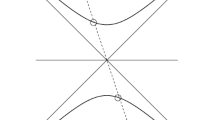Abstract
The effective conductivity of the two-dimensional periodic polygonal tessellations in the plane is determined using the perturbation theory and numerically. A diagram technique in perturbation theory for the effective conductivity of the tesselations in the plane is established using oblique coordinates. Calculations for the three color hexagonal tesselation have been carried out. A numerical method is developed for obtaining effective conductivity with high accuracy both when the perturbation theory is applicable and when the conductivities of the tessellation components are substantially different. For small differences between the conductivities of the components, the approach of the perturbation theory agrees with the numerical results.
Similar content being viewed by others
References
S. Torquato, Random Heterogeneous Materials: Microstructure and Macroscopic Properties (Springer-Verlag, Berlin, 2002).
D. S. Lia, G. Sahelia, M. Khaleelb, and H. Garmestani, Comput. Mater. Sci. 38, 45 (2006).
Yu. P. Emets, Electrical Characteristics of Composite Materials with a Regular Structure (Naukova Dumka, Kiev, 1986) [in Russian].
Lord Rayleigh, Philos. Mag., Ser. 5 34, 481 (1892).
L. D. Landau and E. M. Lifshitz, Course of Theoretical Physics, Volume 8: Electrodynamics of Continuous Media (Butterworth–Heinemann, Oxford, 1984; Fizmatlit, Moscow, 2005).
S. Kirkpatrick, Rev. Mod. Phys. 45, 574 (1973).
A. L. Efros and B. I. Shklovskii, Phys. Status Solidi B 76, 475 (1976).
S. H. Xie, Y. Y. Liu, and J. Y. Li, Appl. Phys. Lett. 92, 243121 (2008).
A. Bagchi and S. Nomura, Compos. Sci. Technol. 66, 1703 (2006).
R. Prasher, W. Evans, P. Meakin, J. Fish, P. Phelan, and P. Keblinski, Appl. Phys. Lett. 89, 143119 (2006).
J. B. Keller, J. Math. Phys. 5, 548 (1964).
A. M. Dykhne, Sov. Phys. JETP 32, 63 (1970).
V. G. Marikhin, JETP Lett. 71 (6), 271 (2000).
Yu. N. Ovchinnikov and A. M. Dyugaev, J. Exp. Theor. Phys. 90 (6), 1058 (2000).
Yu. N. Ovchinnikov and I. A. Luk’yanchuk, J. Exp. Theor. Phys. 94 (1), 203 (2002).
Yu. N. Ovchinnikov, J. Exp. Theor. Phys. 98 (1), 162 (2004).
Yu. P. Emets, Sov. Phys. JETP 69 (2), 397 (1989).
A. M. Satanin, V. V. Skuzovatkin, and S. V. Khor’kov, JETP Lett. 64 (7), 538 (1996).
A. M. Satanin, V. V. Skuzovatkin, and S. V. Khor’kov, J. Exp. Theor. Phys. 85 (2), 351 (1997).
I. M. Khalatnikov and A. Yu. Kamenshchik, J. Exp. Theor. Phys. 91 (6), 1261 (2000).
G. E. Karniadakis and R. M. Kirby II, Parallel Scientific Computing in C++ and MPI (Cambridge University Press, Cambridge, 2003).
V. Voevodin, S. Zhumatii, S. Sobolev, A. Antonov, P. Bryzgalov, D. Nikitenko, K. Stefanov, and V. Voevodin, Otkrytye Sist. 7, 36 (2012).
Author information
Authors and Affiliations
Corresponding author
Additional information
Original Russian Text © L.Yu. Barash, I.M. Khalatnikov, 2015, published in Zhurnal Eksperimental’noi i Teoreticheskoi Fiziki, 2015, Vol. 148, No. 2, pp. 266–274.
Rights and permissions
About this article
Cite this article
Barash, L.Y., Khalatnikov, I.M. Effective conductivity of the rectangular and hexagonal tessellations in the plane. J. Exp. Theor. Phys. 121, 229–236 (2015). https://doi.org/10.1134/S1063776115080014
Received:
Published:
Issue Date:
DOI: https://doi.org/10.1134/S1063776115080014




